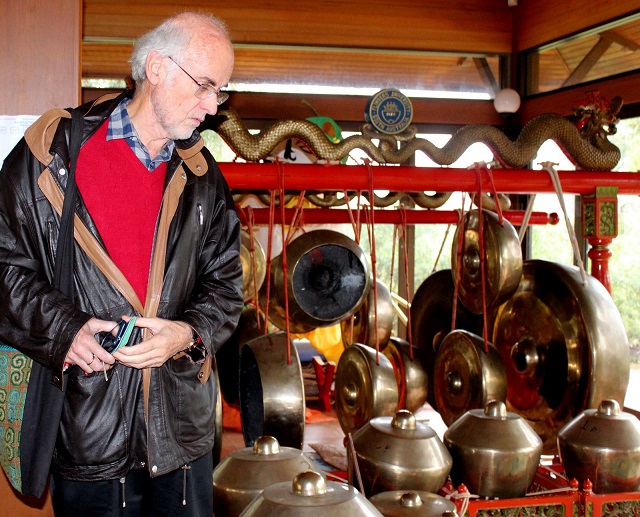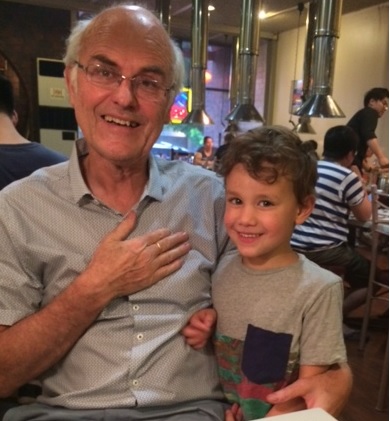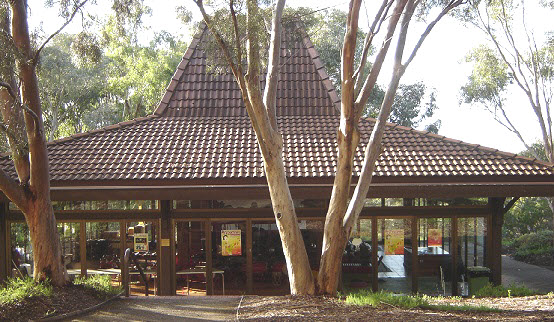A look at the journey and contribution of a longtime Australian teacher and researcher of Indonesian Studies
Duncan Graham
Anton Lucas has spent much of his rich life trying to improve Indonesian-Australian relationships. He has studied and taught in Yogyakarta and Makassar, run an Asian Studies program in Australia for 30 years, written well and widely, and inspired seekers of truths about Indonesia for half a century.
He’s earnest enough to look like an austere academic but sufficiently inquiring to prove a student’s life goes beyond 70. Though powered by faith he doesn’t proselytise. Schooled as a Protestant, Lucas now calls himself a Christian–Buddhist. His son is a Buddhist monk in Indonesia, his daughter a filmmaker.
His rare collection of documents from the early post-Proclamation period including sound recordings and transcripts was given to Flinders University library and the catalogue will eventually go online. The papers were gathered during interviews with 324 survivors of the 1945 ‘Revolution within the Revolution’ around Pekalongan in north Central Java.
His monograph, Peristiwa Tiga Daerah (The Three Regions Affair, 1989), tells of the violent clashes between ruling elites and the people during the chaos that followed the collapse of the Japanese occupation. Lucas regards his next book, One Soul, One Struggle, published in 1991 and soon to be re-released, as a significant accomplishment.
He has also left an architectural legacy behind at Flinders University in Adelaide through his donation of a pendopo. This traditional four-post high timber cube of Javanese culture was built to create a sense of calm and unity despite gulfs of difference in lifestyles, world views and local customs. It’s a communal place for visitors and locals to find common cause and set signposts for others.
The pendopo has a set of gamelan instruments called Sekar Laras (Blossoming Harmonies) from Central Java, which gets used by students, teachers and members of the Indonesian diaspora. The glass walls fold back in summer and metallic music from a lush land drifts and settles among the eucalyptus roots clawing at arid soils.
‘[The gift] was the best thing I ever did,’ Lucas declared before heading to Yogyakarta where he and his wife Kadar have an extended family and friends. The couple’s A$150,000 gesture was revealed only after Lucas retired in 2010.

‘Indonesians can feel at home [there], while Australians can encounter their neighbours,’ Lucas added. ‘It’s not just a tangible symbol for coming together; it also has an emotional dimension and a unique ambience.’
Lucas had a privileged education. Though never gentry his Greek heritage mother had property and sent her studious son to the Anglican Geelong Grammar, famed for nurturing the elite and future leaders.
‘I always thought of myself as a square peg in a round hole,’ he said of his school days. Set for a career as an agricultural economist or broad-acre farmer, he won a scholarship to the East West Centre in 1969, an education and research organisation at the University of Hawaii. The centre opened in 1960 to ‘strengthen relations and understanding among the peoples and nations of Asia, the Pacific, and the US’.
Astonishingly, his Asia Pacific origin meant he was exempted from studying a regional tongue, just having to pass an English test instead. Like most Australians of that era, however, he’d seen his country as more a European outpost than an Asia-Pacific nation.
Another revelation came on meeting members of the Peace Corps, a US government volunteer aid program. They seemed at ease with difference, spoke Asian languages and were driven to better the world. Said Lucas: ‘They were not ugly Americans’.
The Australian’s viewpoints took a left turn towards history, social justice and human rights.
He dropped agricultural-economics and picked up Indonesian, led by a series of curious encounters. One of these came while recovering a lost camera at the home of researcher Herb Feith, who steered him (and many others) towards recent Indonesian history.
Influenced by another world-renowned scholar Tony Reid at the ANU, Lucas researched the Pekalongan ‘revolusi sosial’, also labelled a ‘struggle’ and a ‘movement’, which Lucas noted ‘had never been clearly and coherently depicted’. Others saw the events as a communist revival and labelled it a ‘rebellion’.
The survivors’ stories opened Lucas’s eyes to Indonesia’s complex past and expanded his empathy. The square peg had found the right hole, or as he said: ‘Indonesia fitted me like a glove’.
Yet much was discomforting. In a Yogyakarta jail he saw political activists broken by a brutal system during Suharto’s era of anti-communist paranoia. ‘With a Dutch student pastor I tried to help a boy reconcile with his long jailed military father,’ Lucas said. ‘We failed. This had a huge effect on me.’
At Flinders as an associate professor Lucas was also in demand as a consultant. He worked on the documentary series Riding the Tiger, an ABC film production released in 1992 and directed by Curtis Levy about the human face of authoritarian rule in Indonesia. He also worked on Australian funded research projects in areas including agrarian reform, environment and social capital, and local governance.
He taught Indonesian culture and society, religion and social change and musical identities. He also privately funded Inside Indonesia when it was staggering as a print journal. He remains treasurer. During the Suharto era adding a Catholic nunnery in Central Java to Inside Indonesia’s subscription list seemed a good idea. It wasn’t. The nuns were then accused of spreading Marxism.
Despite fumbles and stumbles, the relationship between Australia and Indonesia improved over time. In 1992 Prime Minister Paul Keating, who was close to Suharto, declared Australia part of Asia. Enrolments at Flinders rose enough to support four full-time academic positions (jobs now shared and limited to two half-time positions).
Five years after the pendopo’s gamelan gongs first stirred the eucalyptus leaves, Lucas and his colleagues organised a one-day conference on Australia-Indonesia relations. An edited book followed: Half a century of Indonesian-Australian interaction, published in 1996.

Australians were developing a positive interest in the people next door. The feeling was mutual. During the 80s and early 90s folks from each nation were getting closer, and wiser about one another. Recalled Lucas: ‘The nineties was the golden era’.
Then the glitter dimmed. Dramatic events included the 1997 Asian Financial Crisis, turmoil following the 1998 fall of Suharto, and high tension during the 1999 East Timor independence referendum.
The 2002 Bali bombings killed 202 people, including 88 Australians. The government shouted travel warnings. Educational visits stopped. Parents no longer wanted their kids to study Indonesian. University administrators found computing and communications more profitable than Asian Studies.
‘To turn this around we all need to do more – and that includes Indonesians studying Australia and hosting seminars about us,’ Lucas said. ‘If we lose a generation of scholars we won’t get them back. The goodwill is not so strong.’
The failure to explain to Indonesians Australia's response to the executions of Andrew Chan and Myuran Sukumaran (including withdrawing the ambassador in 2015), and Australian media responses to the release this year of ganja queen Schapelle Corby, were opportunities missed, believes Lucas: ‘We need to tell our story about our history, multiculturalism and values, such as diversity and equality. As in the pendopo, we should listen to each other and reflect on the relationship we want.’
‘Like we have been doing at the recent Indonesia Council Open Conference (ICOC) which has just ended,’ he reflected. ‘The Indonesian students were inspirational.’
Duncan Graham is an Australian journalist living in East Java. He writes the blog Indonesia Now. Versi Bahasa Indonesia di sini.
Anton Lucas has been a valued member of the board that publishes Inside Indonesia for well over a decade.
